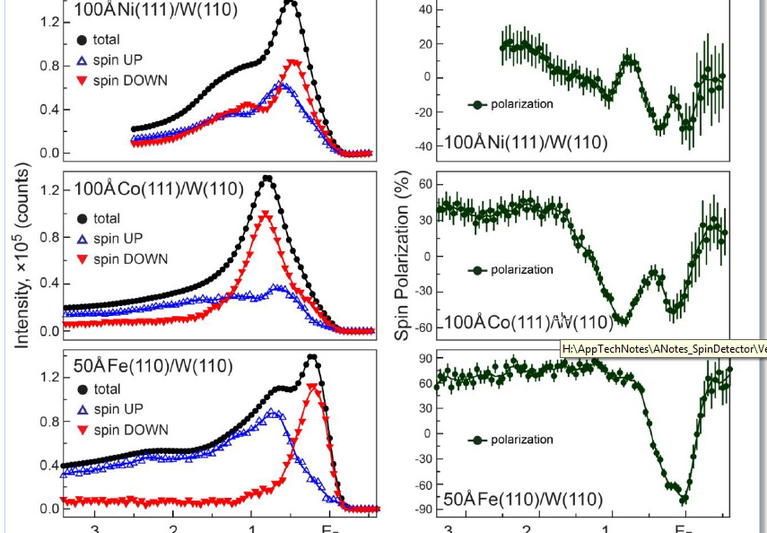 Detail
DetailSpinPES
Experimental methods based on photoemission such as UPS, XPS, ARUPS or ARPES are routinely used to obtain information on the chemical composition and the electronic properties of surfaces. Frequently, it is also desirable to obtain information about the spin of the electrons generated in the emission process. This is of particular interest for materials where one spin-component is dominant (i.e. magnetic films) or where states with a certain spin-polarization are split in energy (i.e. spin-orbit split surface states). The continuous advance in spin detector technology makes spin resolved measurements increasingly feasible, also for systems with intrinsically low count rates.
The spin polarization vector P is the statistical mean of the electron spin relative to some spatial direction for an electron ensemble. The polarization P along some axis is defined as
P = (Nu - Nd)/(Nu+ Nd),
where Nu and Nd are the number of electrons with spinup and spin down, respectively. Most spin detectors are based on electron scattering from a solid. The asymmetry A is defined as
A = (I+ - I-) / (I+ + I-),
where I+ and I- are the intensities measured in two different scattering directions, or with two different incident P .
The Sherman function S is a measure of the spinselectivity of the detector. For an ensemble with polarization P along the axis normal to the scattering plane the measured asymmetry A is given by A = P*S.
For a polarimeter based on scattering, the reflectivity R is of importance as well. Since S and R typically vary with the electron scattering energy, and frequently have maxima at different energies, it makes sense to operate the polarimeter at the energy where the Figure of Merit (FoM) = S2R, is maximum.
The core of any spin detector is the spin polarimeter, where the polarization P is measured. There are different types of spin polarimeters: The classical mini Mott detector is based on spin orbit interaction at scattering energies close to 25 keV. The VLEED spin detector is based on exchange interaction at about 6.5 eV scattering energy. The imaging spin detector is based on spin Orbit interaction at energies in the range 10 to 100 eV. The choice of spin polarimeter depends on the requirements on data acquisition speed and whether imaging spin polarimetry is required.
The Mini Mott polarimeter is based on electron scattering at about 25 kV from a Au or Th target. The spin orbit interaction of the electron with the potential of the target atom leads to a spatial asymmetry in the intensity of scattered electrons, which depends on the spin of the electrons.Todays Mott detectors are quite compact and easy to use. Since the scattering takes place at high energies in the bulk of the target, the process is relatively insensitive to the surface quality of the target, and hence elaborate surface preparation is not necessary. The Mini Mott detector has four channeltrons. Each pair of channeltrons measure the spin asymmetry in one of two directions parallel to the target surface. The ability to acquire two complete components of the spin polarization vector simultaneously makes the Mott detector suitablefor time-critical measurements. Typical values for the Sherman function and the reflectivity are 0.16 and 0.006, respectively. This gives a figure of merit (FoM) of 1.5x10-4.
The FERRUM (FOCUS GmbH) polarimeter is based on Very Low Energy Electron Diffraction (VLEED) on an O-passivated Fe film grown on W(100). The scattering energy is approximately 6.3 eV. In contrast to Mott polarimeters, the Ferrum VLEED spin polarimeter utilizes the exchange interaction between the electrons and the magnetized Fe film. In order to measure one component of the spin polarization vector, it is necessary to measure the intensity twice with opposite magnetization directions. Two orthogonal components of the spin polarization vector can be measured by magnetizing the Fe film in the corresponding directions, using built in magnetization coils.The target surface has to be well ordered and atomically clean.Therefore, the detector has facilities for clean surface preparation and thin film deposition. The detector has two channeltrons, one of which delivers the spin filtered signal. The second channeltron delivers a total intensity signal, which is used for calibration purposes. The detector has double Mu-metal shielding and is delivered with electron beam heating, Fe evaporator, oxygen dozer and all necessary power supplies. The preparation of the W crystal and the Fe film are pre-programmed in the detector electronics and thus automated. A freshly prepared Fe film will be spin selective for several weeks under UHV conditions.
The imaging spin polarimeter are based on the spin selective scattering of electrons at certain single crystal surfaces [Kolbe et al., Phys. Rev. Lett. 107 (2011) 207601]. Since the electron optical image is basically mirrored by the detector, all the position and angle information in the electron optical image is preserved. Examples of scattering surfaces are W(100), Ir(100) orAu/Ir(100). The spin selective scattering is due to spin orbit interaction and occurs for the spin polarization componentnormal to the scattering plane. The spin selectivity of the scattering vary strongly with the scattering energy and angle [D. Kutnyakhov et al, Ultramicroscopy]. Typically, the scattering angle is set by the geometry of the instrument, and the scattering energy is in the range 10 to 100 eV. The maxima in the spin asymmetry function are as high as 80% for some materials [D. Kutnyakhov et al, Ultramicroscopy]. In order to see the difference in the image caused by variations in the spin polarization, it is necessary to vary the spin asymmetry function by changing the scattering energy, or to reverse the spin polarization direction of the electron beam. Thus the acquisition of a spin filtered image requires two consecutive measurements. It is necessary that the scattering surface is well ordered and atomically clean. The spin polarimeter therefore includes the necessary equipment for preparation of the scattering surface.

